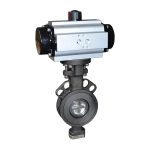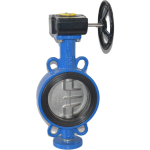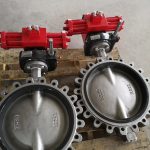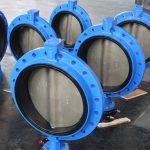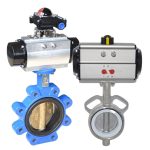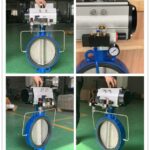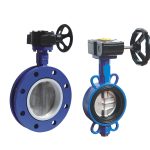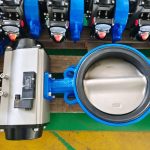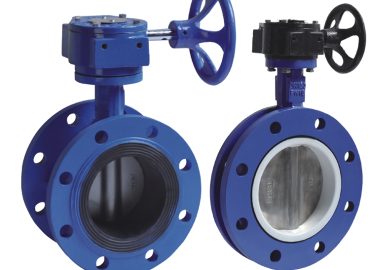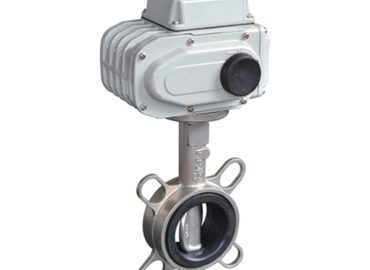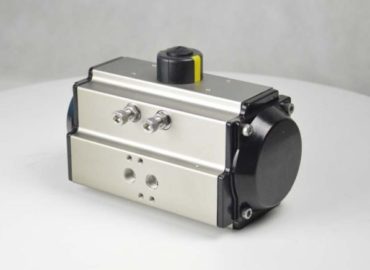In the world of fluid mechanics, butterfly valve play a critical role. They are an integral part of various industries, controlling the flow of liquids through pipes with precision and efficiency. In India, a country blessed with a diverse industrial landscape, the significance of these valves is particularly pronounced. From water treatment plants to oil refineries, butterfly valve are used extensively, ensuring smooth operation and safety. This blog post aims to provide an in-depth understanding of the function and utility of butterfly valve in India, shedding light on their working mechanism, benefits, challenges, and future prospects in the Indian market.
Introduction
Butterfly valves, named for the wing-like action of the disc, which operates at right angles to the flow, are a critical component in various industries in India. They play a pivotal role in controlling the flow of liquids through pipes and are used extensively in several sectors such as water treatment plants, oil refineries, chemical processing units, HVAC systems, and fire protection services. The primary function of a butterfly valve is to regulate fluid flowing through a section of a pipe. This is achieved by using a disk, which turns on a diameter located within the valve’s body to speed up or slow down the flow. When the valve is fully turned, the disk completely blocks off the passageway, stopping all flow. Conversely, when the valve is fully open, the disk rotates a quarter turn so that it allows an almost unrestricted flow of fluid.
The application of butterfly valves is favored due to their efficiency and cost-effectiveness. They are light in weight, require less support, and are relatively easy to install. Moreover, they offer reliable sealing with low torque, allowing for efficient operation and control. However, despite their numerous benefits, there are also challenges associated with butterfly valves. For instance, they might not be suitable for some applications involving high pressures or temperatures or where tight shut-off is required.
Nevertheless, the future of butterfly valves in India appears promising, given the country’s rapidly growing infrastructure and industrial developments. As India continues to urbanize and modernize its industrial sector, the demand for effective and efficient flow control solutions like butterfly valves is expected to rise. Furthermore, advancements in technology and materials science are likely to result in more durable, efficient, and versatile butterfly valves, making them even more valuable to various industries. It’s also worth noting that the Indian government’s initiatives to boost domestic manufacturing under the ‘Make in India’ campaign could lead to increased production and use of locally made butterfly valves, positively impacting the industry.
Brief overview of Butterfly Valve
Butterfly valves are a type of flow control device commonly used in many industrial applications. They consist of a disc mounted on a rotating shaft. When the butterfly valve is fully open, the disc is turned so that it allows fluid to pass through. When the valve is closed, the disc is rotated to block off the passageway. The operation of the valve can be manual or powered. Its simple design, ease of use, and cost-effectiveness make it a popular choice in industries ranging from water distribution and wastewater treatment to oil and gas, chemical processing, and power generation. In essence, butterfly valves offer a practical solution for controlling and isolating the flow of fluids in various systems, contributing significantly to operational efficiency.
Importance of Butterfly valve in different industries
Butterfly valves play an integral role in various industries, primarily due to their function of regulating and isolating the flow of fluids. In the water and wastewater treatment industry, these valves are essential for controlling the flow of water through different treatment stages, ensuring efficient processing and safe disposal. The oil and gas sector relies heavily on butterfly valves for safe and effective transportation of petroleum products through pipelines. In the chemical industry, they are used to control the flow of various corrosive substances, playing a crucial role in maintaining safety standards. The food and beverage industry uses these valves in their sanitary applications due to their ability to maintain a clean and contaminant-free environment. Additionally, in the HVAC industry, butterfly valves help in managing the flow of hot and cold air, contributing to the overall energy efficiency of the systems. Therefore, the importance of butterfly valves extends across different industries, underlining their versatility and utility in diverse applications.

Understanding Butterfly Valve
Butterfly valve are a type of quarter-turn valve that is widely used to manage the flow of fluid in a system. The name “butterfly” comes from the design of the disc that is positioned in the middle of the pipe. When the valve is closed, the disc is turned so that it completely blocks off the passageway. Conversely, when the valve is open, the disc is rotated a quarter turn to allow fluid to flow freely. The operation of the valve can be done manually using a handle or automatically using an actuator.
One of the primary advantages of butterfly valve is their simplicity and compactness. They require less material and space compared to other valve types, making them more cost-effective. Moreover, they are relatively lightweight and require less support. This makes them ideal for large pipe diameters and applications where weight considerations are important. Another advantage is their quick operation – a 90° turn of the handle provides a complete shutoff to full flow.
Despite these advantages, wafer butterfly valve also have their limitations. For instance, they may not provide a completely leak-proof seal, especially in high-pressure applications. Also, the disc obstructs the flow path even when fully open, which can lead to a pressure drop across the valve.
Nonetheless, butterfly valve find wide applications in various industries such as water treatment, power generation, oil and gas, chemical processing, and many others. Their role in these industries is crucial, whether it’s controlling the flow of water in a municipal water system, managing the process flow in a power plant, or regulating the flow of oil in a refinery. Understanding the function and utility of butterfly valve is essential for choosing the right valve for a specific application and ensuring the efficient operation of fluid control systems.
Detailed explanation of Butterfly valve
Butterfly valve, as the name suggests, feature a disc that is centrally positioned and functions similarly to a butterfly’s wings in motion. The disc, which is the closing mechanism, pivots around a central axis within the pipe’s diameter. This disc, when rotated 90 degrees, can completely block the passage or open it up for fluid flow. In the open state, the disc aligns with the direction of the pipeline, allowing fluids to pass through with minimal resistance. Conversely, in the closed state, the disc rotates to a position perpendicular to the flow, blocking the fluid passage.
The operation of lug butterfly valve can be manual or automatic. Manual operation is typically achieved using a handwheel or lever, which allows precise control over the positioning of the disc. For larger valves or when precise control is required, an actuator may be used. Actuators can be powered by electricity, air (pneumatic), or liquids (hydraulic).
One of the key advantages of butterfly valve is their compact size and light weight compared to other valve types like gate, globe, or ball valves. This makes them ideal for applications where space and weight are a concern. Moreover, they are relatively easy to install and maintain, adding to their appeal in various industrial applications.
Despite these advantages, butterfly valve do have some limitations. They may not provide a perfect seal, especially under high pressure or with certain types of fluids. This can lead to leakage. Additionally, even when fully open, the disc intrudes slightly into the pipeline, which can cause a small pressure drop.
Butterfly valve are incredibly versatile and find use in a variety of industries, including water treatment, oil and gas, chemical processing, HVAC systems, and more. Their role in regulating the flow of fluids in these systems is invaluable, making them an essential component in many industrial processes.
How a Butterfly Valve works
A butterfly valve operates by using a disc, which is the main component of the valve. This disc is mounted on a rotating shaft. When the butterfly valve is fully open, the disc rotates to align with the direction of the fluid flow, allowing the fluid to pass through with minimal obstruction. As the valve begins to close, the disc is rotated a quarter turn (90 degrees) so that it’s perpendicular to the flow of fluid. This action blocks the passage of fluid completely. The degree to which the disc is opened or closed – and thus the amount of fluid that’s allowed to flow – can be controlled by turning the valve’s handle or actuator. The actuator can be manually operated, but in larger valves or in automated systems, it may be driven by electric, pneumatic, or hydraulic systems. It’s important to note that while butterfly valve are effective for starting and stopping fluid flow, they don’t provide the fine control of flow rate that some other types of valves do. Nonetheless, their simplicity, reliability, and cost-effectiveness make them a popular choice in many industrial applications.
Types of Butterfly Valve
Butterfly valve come in various types, each designed to meet specific needs and applications. The most common types include the concentric, double offset, and triple offset butterfly valve.
The concentric butterfly valve, also known as a resilient-seated butterfly valve, is the simplest and most commonly used type. It features a resilient rubber seat with a metal disc positioned in the middle of the pipe. When the valve is closed, the disc is pushed against the seat to create a seal.
Double offset butterfly valves, also known as high-performance butterfly valve, have an off-center stem that allows the disc to move off the seat in a cam-like action. This design reduces wear and tear on the valve, making it suitable for higher pressure and temperature applications than the concentric type.
Finally, triple offset butterfly valve, also known as triple eccentric valves, feature a metal seat and seal which are not subject to the same levels of wear as the rubber seat in a concentric valve. This design makes them ideal for very high-pressure and high-temperature applications where a tight seal is critical.
Each type of butterfly valve has its unique advantages and disadvantages, and the selection of the appropriate type depends on the specific requirements of the application, including the nature of the fluid, the required flow rate, and the environmental conditions under which the valve will operate.
Usage of Butterfly Valve in India
In India, butterfly valve are extensively used in various industrial applications due to their efficiency in stopping, regulating, and starting the flow of fluids. These valves are highly appreciated for their easy and quick operation, making them a staple in industries handling large volumes of fluid. They are often employed in water-based systems for low-pressure applications, but they’re also useful in controlling the flow of air, gases, and even certain types of solids. For instance, they’re commonly used in the circulation of water or for fire protection systems.
Moreover, the oil and gas industry in India is a significant consumer of these valves, specifically favoring stainless steel butterfly valve due to their durability and resistance to corrosive substances. Additionally, butterfly valve have found usage in special applications like isolation, throttling, and control, making them suitable for a wide range of industrial processes.
Given the versatile nature of butterfly valve and their critical role in industrial processes, several manufacturers and suppliers are offering high-quality butterfly valve in India, catering to the growing demand. The forecasted growth of the butterfly valve market further illustrates their importance in India’s industrial landscape. With an expected market size of $13.66 billion by 2025, the usage of butterfly valve in India is likely to continue increasing in the years to come.
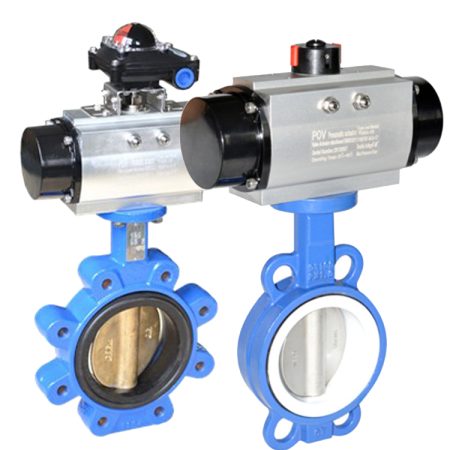
Industries that use Butterfly Valve in India
Butterfly valve have a wide range of applications in several industries across India. They are extensively used in the Chemical, Oil & Gas industries due to their efficiency and durability. Numerous manufacturers and suppliers, including prominent companies like L&T Valves, Amtech Valves, and Hawa Valves, cater to this demand. Kirloskar Valves, one of Pune’s largest manufacturers of industrial valves, is known for its range of butterfly valve. Other industries that utilize butterfly valve include food processing, chemical, and pharmaceutical services, highlighting the valve’s versatility. The high-temperature and high-pressure environments often found in these industries make butterfly valve an ideal choice for controlling the flow of fluids. As such, butterfly valve play a pivotal role in India’s industrial landscape, facilitating efficient operations across various sectors.
The role of Butterfly valve in these industries
Butterfly valve play a crucial role in various industries due to their ability to control the flow of liquids, gases, and even certain types of solids. In the oil and gas industry, for instance, butterfly valve are used to regulate the flow of crude oil and natural gas in pipelines, ensuring optimal operational efficiency. They are also used to isolate sections of the pipeline for maintenance or in case of an emergency shutdown. In the chemical industry, these valves are essential for safely managing the flow of corrosive substances and high-temperature liquids.
The food processing industry uses butterfly valve to control the flow of liquid food products, such as juices, sauces, and dairy. These valves are often preferred because they are easy to clean and maintain, reducing the risk of contamination. In pharmaceutical industries, they are used in applications where hygiene is paramount, such as in biotech processes and clean utilities. Butterfly valves’ ability to provide a tight shut-off also makes them suitable for use in water treatment plants, where they are used to regulate the flow of water and help maintain the proper functioning of the system. Thus, butterfly valve have a significant impact on the smooth operation of these industries, contributing to their overall productivity and safety.
Benefits of Using Butterfly Valve
Butterfly valve offer numerous advantages that make them a popular choice for many industrial applications. One of the primary benefits is their simple and compact design which allows for easy installation and maintenance. They are lighter in weight compared to other types of valves such as gate or globe valves, which makes them easier to handle and install, especially in large-scale operations.
Butterfly valve also provide efficient flow control. They can be quickly opened or closed with a 90-degree rotation of the handle, allowing for fast isolation and regulation of flow. This quick operation makes them ideal for emergency shut-off situations.
Another significant advantage of butterfly valve is their versatility. They can handle a wide range of temperatures and pressures, and they can be used with various types of fluids, including water, oil, and corrosive chemicals. This versatility extends to their construction materials as well, with options ranging from cast iron and stainless steel to high-performance materials like Hastelloy and Inconel, which can withstand extreme environments.
Furthermore, butterfly valve are cost-effective. They are generally less expensive than other types of valves and, due to their durability and low maintenance requirements, they tend to have a lower total cost of ownership. This, coupled with their efficiency and versatility, makes butterfly valve an excellent choice for a variety of industrial applications.
Efficiency and Cost-Effectiveness
Efficiency and cost-effectiveness are two critical factors that significantly impact the overall success and profitability of any business operation. Efficiency refers to achieving maximum productivity with minimum wasted effort or expense. It is about doing things right, minimizing errors, and streamlining processes to save time and resources. An efficient system or process can lead to improved quality, faster turnaround times, and increased customer satisfaction. On the other hand, cost-effectiveness relates to providing good value for the amount of money spent. It’s not just about being cheap; it’s about maximizing the benefit gained from each dollar spent. A cost-effective solution might not always be the least expensive upfront but will provide more value over time, considering factors like maintenance costs, durability, and the potential for increased productivity. In many cases, investing in efficiency can lead to cost-effectiveness in the long run. For instance, adopting modern technology or equipment might require an initial investment, but the increase in efficiency can lead to significant cost savings over time. Therefore, businesses continuously strive to improve both efficiency and cost-effectiveness to stay competitive and maintain healthy profit margins.
Durability and Low Maintenance
Durability and low maintenance are key attributes sought after in many products and systems across various industries. Durability refers to the ability of a product or system to withstand wear, pressure, or damage, thereby extending its useful life. Durable goods, such as industrial machinery or equipment, are designed to last for several years, even under harsh operating conditions. This longevity can lead to significant cost savings over time, as the need for replacement is minimized. On the other hand, low maintenance implies that the product or system requires minimal effort to keep it in good working condition. Low-maintenance products or systems often have simple designs with fewer components that can break or wear out, and they may also be built with high-quality materials that resist wear and tear. They typically require fewer repairs and less frequent servicing, which can save both time and money. Moreover, the reliability of low-maintenance items can help prevent unexpected downtime, thereby enhancing productivity. Therefore, investing in durable and low-maintenance products or systems can be a smart business decision that contributes to long-term savings and operational efficiency.
Versatility of Applications
Versatility of applications is a crucial factor in the design and selection of many products and systems. It refers to the ability of a product or system to adapt and function effectively across a wide range of tasks, environments, or scenarios. A product with versatile applications can be used in various industries or for different purposes, making it a valuable asset for users. For instance, a software program that can handle data management, project planning, and customer relationship management is more versatile than a program designed for only one of these tasks. This versatility can lead to cost savings, as a single, multifunctional tool can replace several specialized ones. Moreover, versatile products or systems are often designed to be scalable and adaptable, meaning they can evolve with changing needs or advancements in technology. This feature can provide long-term value and flexibility, ensuring that the product remains useful and relevant over time. Consequently, the versatility of applications is a key consideration in today’s fast-paced and ever-changing technological landscape.
Challenges Faced in the Indian Butterfly Valves Industry
The Indian Butterfly Valve industry is grappling with a multitude of challenges that are impacting its growth and profitability. One of the major concerns is the increasing competition from alternative valve technologies such as gate and globe valves, which are gaining traction due to their efficiency and versatility in various industrial applications. Furthermore, the industry’s growth is predicted to be hampered by limited throttling capabilities of butterfly valves and intense competition from local producers offering cost-effective solutions. The outbreak of COVID-19 in 2020 also posed significant challenges to the butterfly valve market, disrupting supply chains and causing a slowdown in manufacturing activities. Indian manufacturers also face a significant risk of leakage associated with butterfly valves, which could lead to wastage and increased operational costs. Despite these challenges, the global butterfly valve market is estimated to garner a revenue of USD 14102 Million by the end of 2033, growing at a CAGR of ~7% over the forecast period. However, for the Indian Butterfly Valve industry to claim a significant share of this growth, it needs to address these challenges effectively, perhaps through technological innovation, quality improvements, and strategic partnerships.

Conclusion
In conclusion, butterfly valve play a crucial role in a myriad of industries in India. Their function and utility are integral to maintaining smooth operations, particularly in sectors like water and wastewater treatment, oil and gas, and power generation. Despite their simplicity, butterfly valve offer excellent control of fluid flow, easy operation, and cost-effectiveness, making them an attractive option for various applications.
However, like any other industry, the butterfly valve sector in India is not without its challenges. From intense competition from local and international manufacturers to the adoption of alternative valve technologies, the landscape is highly competitive. The COVID-19 pandemic has further compounded these challenges by disrupting supply chains and slowing down manufacturing activities. Additionally, the risk of leakage associated with butterfly valve remains a significant concern that can lead to wastage and increased operational costs.
Yet, despite these hurdles, the future holds promise. With the global butterfly valve market projected to grow significantly over the coming years, there are ample opportunities for the Indian industry to capitalize on. This will require addressing the existing challenges effectively through technological innovation, quality improvements, and strategic partnerships.
Moreover, there is an increasing focus on sustainability and energy efficiency in the industrial sector. Butterfly valve, with their potential for automation and energy-saving capabilities, can cater to this growing demand. Hence, manufacturers who can integrate these features into their products will have a competitive edge.
Finally, understanding the function and utility of butterfly valve is just one piece of the puzzle. Navigating the regulatory landscape, staying abreast of the latest technological developments, and adapting to changing market dynamics are equally important. Only then can the Indian butterfly valve industry continue to thrive and contribute to the country’s industrial growth. As we move forward, it will be interesting to see how the industry evolves and adapts to meet these changing needs and challenges.



